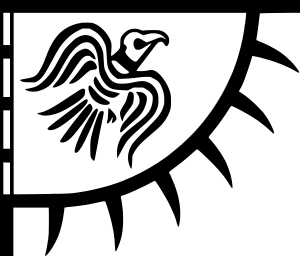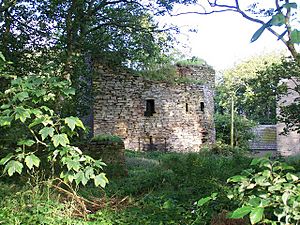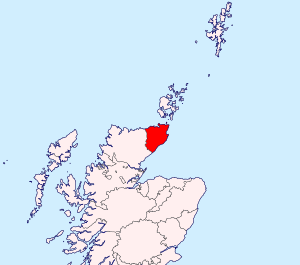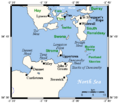Mormaer of Caithness facts for kids
Quick facts for kids Mormaer of Caithness |
|
|---|---|

Raven banner
|
|
| Creation date | 10th century? |
| Monarch | Constantine II of Scotland? |
| Peerage | Peerage of Scotland |
| First holder | Donnchad? |
| Last holder | Maol Íosa |
| Status | Extinct |
| Extinction date | 1350 |
| Former seat(s) | Braal Castle |
The Mormaer of Caithness was a special title for a powerful leader in a region called Caithness, in northern Scotland. This title was like being a local ruler or an earl. For a long time, from the Viking Age until 1350, this title was mostly held by important people from Norway. These leaders were also the Earls of Orkney.
This meant they were vassals, or loyal supporters, to two different kings at the same time. They were loyal to the King of Norway for Orkney and to the King of Scots for Caithness. This was very unusual in history!
The first person mentioned with this title was a Scottish ruler named Donnchad. This was around the early 900s. However, it's not clear how much control the Scottish king really had over Caithness back then. By the early 1000s, the Earls of Orkney, who were Norse, became the main rulers of Caithness.
Contents
Understanding the Mormaer Title
A mormaer was a powerful ruler in early medieval Scotland. It's similar to an earl. They controlled a large area of land called a mormaerdom. The Mormaer of Caithness was a very important position because it connected Scotland with the Norse lands of Orkney.
The Unique Dual Loyalty
The Earls of Orkney, who also held the Caithness title, had a tricky job. They had to be loyal to both the King of Norway and the King of Scots. This meant they had to balance their duties and avoid upsetting either powerful ruler. No other family of earls in history had this kind of double loyalty.
The Pentland Firth is a stretch of water between Caithness and Orkney. For the Norse people, who were skilled sailors, this water didn't divide them. Instead, it helped connect Caithness and Orkney. They often traveled across it, treating both areas as one big region.
For example, in the 1100s, a Norwegian king could easily capture the Earl of Orkney from his home in Thurso, Caithness. At the same time, the Scottish king, David I, also had influence in both areas. He used the Church and other peaceful ways to show his power.
After a big battle called the Battle of Largs in 1263 and a peace treaty in 1266, the border became much clearer. The Pentland Firth then became more like a "state border" between Scotland and Norway.
Sutherland's Connection to Caithness
For most of its history, the area known as Sutherland was part of the Caithness mormaerdom. However, King Alexander II later took Sutherland away from Magnus, who was an Earl of Orkney and Caithness. He gave it to other people for reasons that are not fully known today.
Early Mormaers of Caithness
It's hard to know exact dates for the earliest mormaers because old records are often missing or unclear. However, we do have some information about these early rulers.
| Dates | Mormaer | Notes |
|---|---|---|
| Early 10th century | Donnchad of Caithness | Donnchad was married to Groa, the daughter of a Viking leader named Thorstein Olafsson. |
| Mid 10th century | Uncertain | Thorfinn Torf-Einarsson was a powerful Earl of Orkney. He was married to Donnchad's daughter, Gruaidh. We don't know for sure if he was also Mormaer of Caithness. |
| 978–980s? | Skuli Thorfinnsson | Son of Gruaidh and Thorfinn. He was supported by the Scottish King Kenneth II. Skuli was defeated in battle by his brother Ljot in Caithness. |
| 980s? | Ljot Thorfinnsson | Ljot defeated Skuli, but this angered the Scots. Ljot died from his wounds after another battle near Wick. |
| 980s | Hlodvir Thorfinnsson | He became Earl of Orkney after Ljot. He was buried in Caithness, which suggests he had control over the area. |
| 991 to 1014 | Sigurd Hlodvirsson | Earl of Orkney. He was strong enough to protect Caithness from the Scots. He died in a famous battle in Ireland in 1014. |
| 1014–c.1060 | Thorfinn Sigurdsson | When his father Sigurd died, Thorfinn's older brothers divided Orkney. His grandfather, the King of Scotland, made Thorfinn the ruler of Caithness and Sutherland. |
| Mid-11th century | Madadhan of Caithness | The Orkneyinga saga (a Norse story) says "Muddan" became the leader of Caithness. He was killed by Thorkel, an ally of Thorfinn Sigurdsson. |
| Mid-11th century | Thorfinn Sigurdsson? | It's likely that Thorfinn regained control of Caithness after Muddan's death, as he was a very powerful earl. |
| To 1098 | Paul and Erlend Thorfinnsson? | After Earl Thorfinn's death, his sons Paul and Erlend ruled Orkney together. It's not clear what happened to the Caithness title during this time. |
A Short Norwegian Takeover
In 1098, Magnus Barefoot, the King of Norway, took control of Orkney. He removed the Thorfinnsson brothers and put his own young son, Sigurd Magnusson, in charge. King Magnus also led strong military campaigns in other parts of Scotland and Ireland.
It's likely that King Magnus had control over Caithness too, before he died in 1103. However, Norway didn't officially take over Caithness. It remained under the Scottish crown. It's possible that local Scottish leaders briefly regained the title during this time.
Later Norse Rulers
| Dates | Mormaer | Notes |
|---|---|---|
| c.1104 - c.1105 | Haakon Paulsson | Grandson of Thorfinn Sigurdsson. He was made Earl of Orkney by the young King Sigurd of Norway and also claimed Caithness. |
| c. 1105 - 1114 | Magnus Erlendsson | Haakon Paulsson's cousin. He was a joint Earl of Orkney until Haakon killed him. Caithness was part of his lands. |
| 1114-1123 | Haakon Paulsson | As the sole Earl of Orkney, he likely regained control of Caithness after Magnus's death. |
| 1123-1128 | Harald Haakonsson | Son of Haakon Paulsson. He "held Caithness from the king of Scots." |
| 1128-1136 | Paul Haakonsson | Half-brother of Harald. He ruled Orkney and probably Caithness, sometimes with Harald, then alone, and briefly with Rögnvald Kali Kolsson. |
| 1136-1151 (jointly 1139-58) | Rögnvald Kali Kolsson | Earl of Orkney and likely ruler of Caithness for much of his time. |
| 1151-54 | Erlend Haraldsson | Son of Harald Haakonsson. He got half of his father's lands in Caithness from the Scottish King Malcolm IV of Scotland when Earl Rögnvald went on a pilgrimage. |
| 1139-1206 | Harald "the Old" Maddadsson | Grandson of Haakon Paulsson. He became a joint Earl of Orkney as a child. He was captured in Thurso by the King of Norway but later became the sole ruler of Orkney and Caithness until his death. |
| 1198 | Harald "the Younger" Eiriksson | Grandson of Rögnvald Kali Kolsson. The Scottish King William the Lion gave him half of Caithness. However, he died that same year in a fight with Harald Maddadsson. |
| 1206-1214 | David Haraldsson | Son of Harald "the Old." He ruled Caithness and Orkney together with his brother Jon. |
| 1214-1230 | Jon Haraldsson | Ruled jointly with his brother David, then alone. He was murdered in Thurso. |

Around 1200, after Harald the Younger's death, the Scottish king asked Rognvaldr Gudrodsson, the King of the Isles, to take Caithness for Scotland. Rognvaldr marched north, took control, and left three stewards (managers) in charge. He was related to the Norse earls of Orkney. There's no clear proof he was officially made Mormaer of Caithness, but he did manage the area for a short time. Harald Maddadsson soon regained full control.
Rulers from Angus and Strathearn Families
After Jon Haraldsson died in 1230, there were no direct male heirs. Two different families claimed the title. In 1232, the people claiming the title for Orkney were lost at sea. So, the Caithness title eventually went to a family connected to the Earl of Angus.
| Dates | Mormaer | Notes |
|---|---|---|
| 1235 | Walter Comyn, Mormaer of Menteith | Comyn signed a document as "Earl of Caithness" in 1235. This may have been a temporary role. |
| 1236-1239 | Magnus II | Also Earl of Orkney. He was given Caithness in two parts. His family background is not fully clear. King Alexander II took Sutherland from Magnus and gave it to someone else. |
| 1239?-1256 | Gilbert | Gilbert (also known as Gille Brigte) ruled both Caithness and Orkney. His exact relationship to Magnus is not clear. |
| 1256-1273 | Magnus Gilbertsson | Son of Gilbert. Magnus supported the King of Norway in a war against Scotland. In 1263, Caithness made a separate peace treaty and paid a fine. |
| 1273-1284 | Magnus Magnusson | Son of Magnus Gilbertsson. |
| 1284-1303 | Jón Magnússon | Son of Magnus Gilbertsson. He was careful to balance his loyalty to both Scottish and Norwegian kings. |
| 1303-1320 | Magnus Jónsson | Son of Jón Magnússon. He was a minor (underage) when his father died. He signed an important Scottish document called the Declaration of Arbroath in 1320. |
| 1321-1330 | Uncertain | There was a gap in the records after Magnus Jónsson's death. It's possible he had a young heir who died. |
| 1330-1350 | Maol Íosa | After Magnus Jónsson, the title was given to Maol Íosa, who was the Mormaer of Strathearn. He was a distant relative of Earl Gilbert. He ruled both Orkney and Caithness. He had several daughters but no sons. |
The End of the Mormaerdom

After Maol Íosa, there was no Mormaer of Caithness from about 1350 to 1379. Alexander of Ard, who was Maol Íosa's grandson, was considered the rightful heir. However, he gave up his claim to King Robert II in 1375. He might have done this for money or for the king's support in becoming Earl of Orkney.
The powerful William III, Earl of Ross then took control in Caithness. After this time, the title "Earl of Caithness" was given to David Stewart, 1st Earl of Caithness. He was a younger son of King Robert II. From then on, the leaders of Caithness were called "Earls" instead of "Mormaers."
Images for kids
-
The Pentland Firth, the "waterway which divided - or united - the Earldoms of Caithness and Orkney". Caithness is to the south and some of the Orkney islands are to the north.
-
Ruins of the Castle of Old Wick, a twelfth- or thirteenth-century fortress, which may have been a winter residence of Harald Maddadsson.





